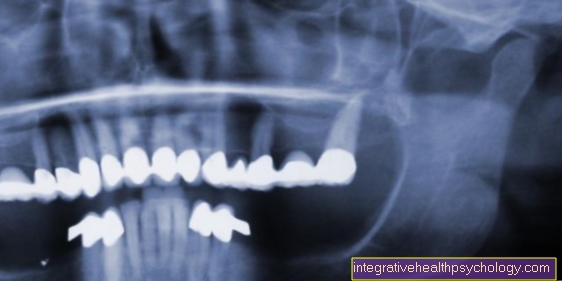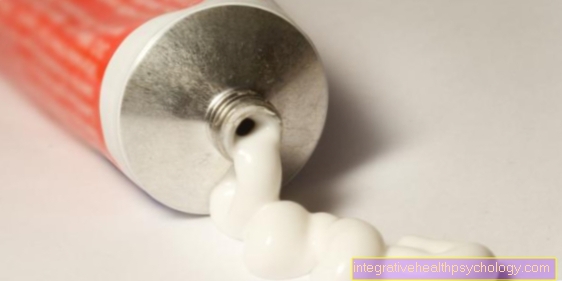Conduction anesthesia
definition
The conduction anesthesia is a local anesthetic. Since the nerves continue to divide starting from the spinal cord, anesthesia in one place can numb all areas further away from the trunk of the body. This form of anesthesia is used particularly for operations on the hands or forearms and also in dentistry. The person concerned is awake and accessible during the procedure.

indication
As in all areas of medicine, in anesthesia the principle of intervening as little as possible in body functions applies. Therefore, the anesthetic procedure is usually chosen to be as minimal as possible for the planned procedure. If the purely local anesthesia is not sufficient, conduction anesthesia is chosen. If this is also insufficient, spinal anesthesia or even general anesthesia is performed.
However, as long as conduction anesthesia is sufficient to perform an operation on the arms, legs or teeth, this option should also be used. Conduction anesthesia is particularly useful for areas that are far away from the trunk of the body, such as the wrist. It is important that the nerves concerned are easily accessible. Conduction anesthesia offers great advantages, especially for older people who suffer more from the effects of general anesthesia, as this method does not affect the central nervous system.
Another area of application for line anesthesia is dentistry. For interventions on the teeth, local anesthesia of the responsible nerves in the area of the jaw is sufficient to completely numb the teeth and thus to carry out the treatment painlessly.
Read more on the topic: Local anesthesia at the dentist
Which anesthetic method is used is always a joint decision of the anesthetists and the patient.
execution
For each type of anesthetic, precise planning is first carried out. This includes in particular a conversation with the person concerned, whether a conduction anesthesia has already been carried out and whether this was well tolerated. Depending on the procedure, the position of the anesthetic and the appropriate local anesthetic are selected.
In the case of deeper nerve bundles, such as the arm plexus, an ultrasound device can be used to find the exact position. The puncture site is disinfected and the medication is drawn into a syringe. The cannula is inserted into the skin and pushed forward to the appropriate place. There it is first checked whether the cannula is outside of the blood vessels, since the local anesthetics should not get into the bloodstream. Then several depots of the local anesthetic are injected around the nerve.
Depending on the application, an electrical measurement can be used to determine whether the anesthesia is successful or whether more medication is necessary. The cannula is withdrawn and a few minutes are allowed to take effect.
Anxious patients can be given a sedative, such as midazolam, before the anesthetic, so that they don't notice much of the anesthetic and the procedure.
What drugs are used
The oldest local anesthetic is cocaine, which is now only known as a drug. Although this is actually no longer used in medicine, the current local anesthetics work in the same way. Bubivacaine, lidocaine, ropivacaine, prilocaine, procaine and some other substances are used.
The various drugs differ in their effectiveness, their duration of action, the time to onset and in their controllability.
Lidocaine has particularly proven itself in dentistry. Which means is used depends on the type and duration of the procedure and the individual tolerance.
Risks and Side Effects
When used correctly and without the local anesthetic getting into the bloodstream, the side effects are minor and much easier than with general anesthesia. Local intolerance and swelling are possible. If you have a known allergy, you should choose a different anesthetic method, as allergic reactions up to allergic shock are possible.
If the local anesthetic gets into the blood and is distributed throughout the body, the side effects increase depending on the concentration in the blood. Initially, dizziness, headaches, drowsiness and nausea are possible. A coma and respiratory paralysis can occur at a higher dose.
The local anesthetics also have effects on the cardiovascular system. The blood pressure drops and the heart's beating power decreases. Furthermore, it can also lead to a slowing down of the heartbeat and a cardiac arrhythmia. In extreme cases, it can lead to cardiovascular arrest.
Read more on the topic: Side effects of local anesthesia
Because of these possible side effects on the cardiovascular system, severe cardiac conduction disorders and decompensated cardiac fatigue are contraindications for conduction anesthesia. In this case, the person concerned can be better controlled under general anesthesia.
Duration
The duration of central anesthesia depends on several factors. The different local anesthetics have different times of action. For short interventions, around less than an hour, a single dose of the local anesthetic is sufficient. However, longer operations can also be performed under conduction anesthesia. To do this, the anesthetist leaves a catheter in the anesthetic area and can administer another dose of local anesthetic if necessary. The conduction anesthesia only lasts a few hours without further anesthesia.
Read more on the topic: Femoral catheter
Oberst's conduction anesthesia
A line anesthesia according to Oberst is an anesthetic procedure for fingers and toes. The procedure is used both in emergencies after injuries and during planned operations. Each finger or toe has a total of four main nerves, all of which must be numbed. Two nerves are on the flexor side and two on the extensor side. With the Oberst conduction anesthesia, all four nerves are numbed with just two punctures.
The cannula is inserted on the extensor side and advanced along the bone to the nerves on the flexor side. There the first amount of local anesthetic is injected. After pulling back slightly, another amount can be injected on the extensor side. The same thing is repeated on the other side of the finger or toe. After just a few minutes, the finger or toe is completely pain-free and an operation can be performed.
Since the responsible muscles are on the forearm or lower leg, mobility is maintained and only the sensitivity to touch and pain is switched off. The name Oberst goes back to a German surgeon in the 19th and 20th centuries who developed this anesthetic technique.
Conduction anesthesia on the upper jaw
In the case of dental treatment, conduction anesthesia can be used to enable a painless procedure. For the upper jaw is the Superior alveolar nerve responsible, which comes directly from the middle branch of a cranial nerve, called Trigeminal nerve, descends. Each tooth has its own branch from the main nerve and depending on where the anesthetic is placed, only a few teeth and the external gums become numb.
The cannula is usually inserted into the top of the gum line and lidocaine is injected. Some dentists use a combination of the local anesthetic lidocaine and adrenaline to prevent excessive bleeding.
The anesthetic sets in after a few minutes and lasts for about two hours. Before the anesthesia, the dentist asks whether previous local anesthesia was well tolerated. There is usually no success control. If pain persists when starting treatment, a second dose of local anesthetic will be given. Since the effect only lasts for a short time, the person concerned can leave the practice after the treatment and does not have to be checked further.
Conduction anesthesia on the lower jaw
For dental treatments on the lower jaw, the procedure is basically the same as on the upper jaw. After making sure that previous treatments have been well tolerated, the lower one becomes Alveolar nerve stunned. This goes out of the Mandibular nerve, i.e. the mandibular nerve. This nerve branch also belongs to the cranial nerve Trigeminal nerve.
In contrast to the upper jaw, however, a single syringe is sufficient for the lower nerve to completely numb the respective half of the lower jaw. The nerve first runs through the lower jaw bone and leaves it in the area of the molars. At this point the anesthetic can be set. The only way to monitor success is by feeling pain at the beginning of the treatment.
Again, the anesthetic lasts about two hours after the last injection. A new dose of local anesthetic may be necessary during longer interventions. As long as the anesthetic is working, the muscle strength of the lip muscles is also weakened. This means that it is not yet possible to properly eat and drink at this time, as the lower lip hangs down on the numbed side.
You might also be interested in: Anesthesia at the dentist
Foot block
With the central anesthesia foot block, all nerves that supply the foot are numbed above the ankle. A total of five injections are necessary for this. After thorough disinfection, approximately three to five milliliters of xylocaine or ropivacaine are injected near the respective nerve.
Local side effects can be hematoma or nerve damage. Various operations on the foot and toe can be performed under a foot block.
A foot block should not be performed if the ankle is infected or if there is blood clotting disorders.
Does it have to be clarified?
In principle, there is an obligation to provide information to every medical intervention. The person concerned must be informed about the procedure, possible side effects and long-term consequences. An overview of alternative anesthetic procedures is also part of the information. The person concerned must also have the opportunity to ask questions. An information sheet with a signature, as with general anesthesia, is not absolutely necessary. Oral information is sufficient. Depending on the risk and type of intervention, the clarification takes place in different detail.








.jpg)




















